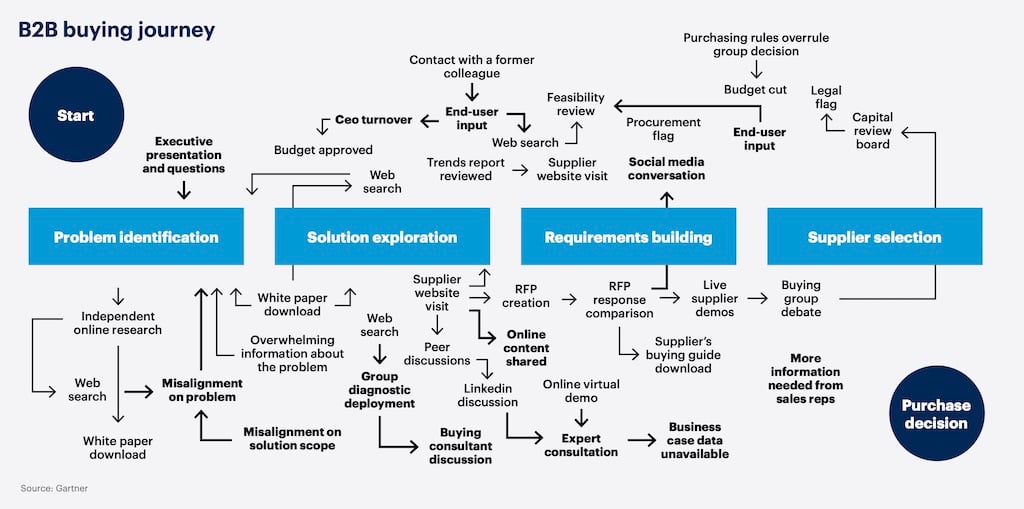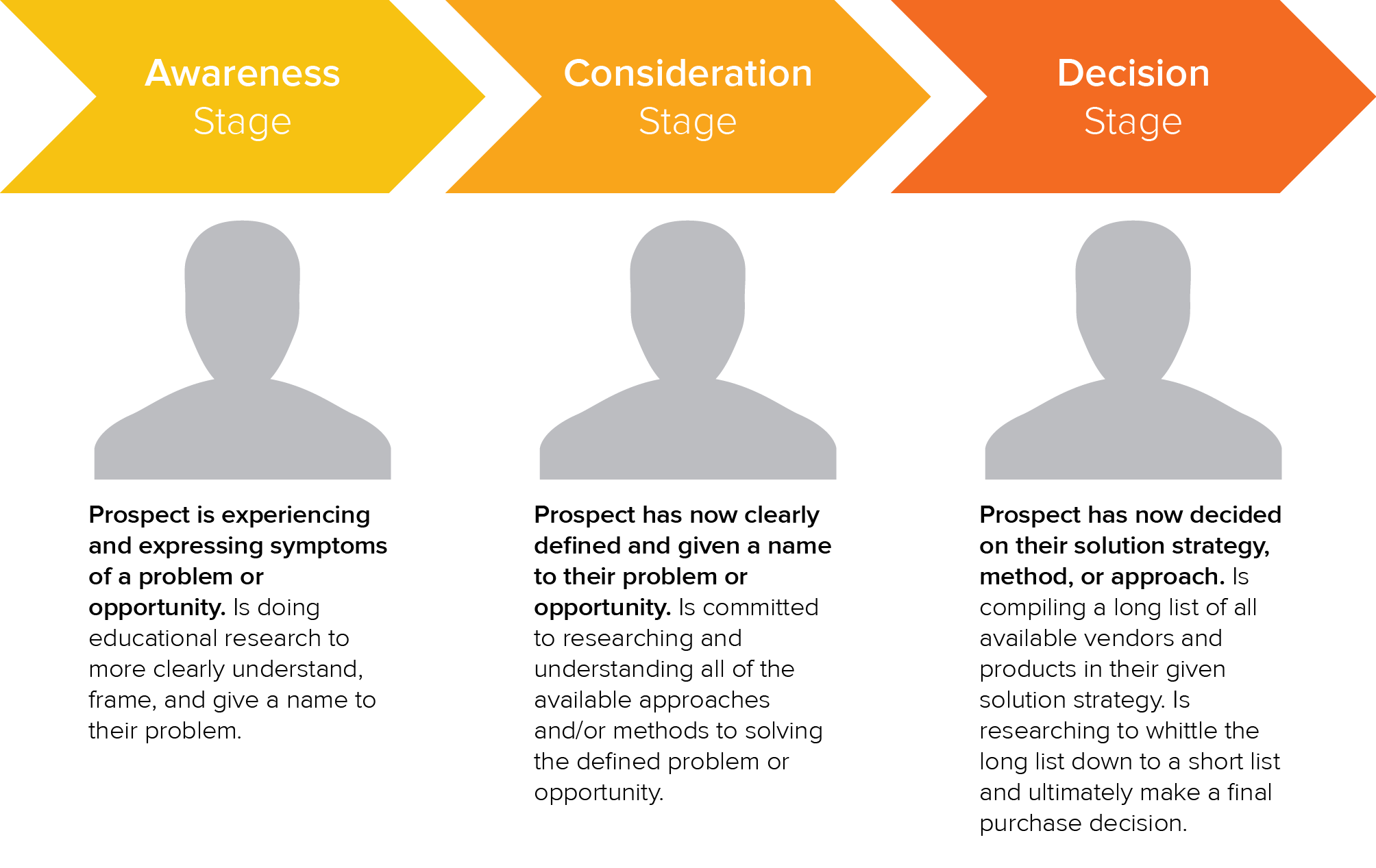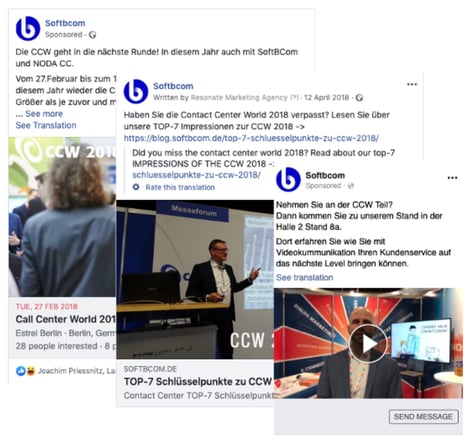Software companies need to be especially mindful of the long sales cycles and high lifetime value typically associated with B2B marketing.
Surveys shows that most businesses take more than three months to complete a software purchase, with 35% citing three to six months and 27% taking six to nine months to make the purchase. The extended process is attributed to multiple stakeholders in the buying process, buyers preferring self-guided search over sales meetups, and difficulty in reaching consensus among decision makers who have very different and often conflicting views of the purchase. Software/Tech providers can make it easier to navigate the purchase process by providing potential buyers with helpful information, tools, and demos, which can simplify decision-making and foster consensus.
 To maximize their chances of success, companies should build comprehensive marketing campaigns that use multiple channels across the entire buyer's journey. For instance, search ads, display ads, content marketing and outbound email campaigns can be used to draw initial interest in the product and create an awareness of the product's features and benefits. After the initial contact, companies should focus on providing helpful resources, such as white papers, e-books, and case studies, to establish thought leadership and credibility. Finally, personal outreach through sales calls or meetings can help to make the sales pitch and close the deal.
To maximize their chances of success, companies should build comprehensive marketing campaigns that use multiple channels across the entire buyer's journey. For instance, search ads, display ads, content marketing and outbound email campaigns can be used to draw initial interest in the product and create an awareness of the product's features and benefits. After the initial contact, companies should focus on providing helpful resources, such as white papers, e-books, and case studies, to establish thought leadership and credibility. Finally, personal outreach through sales calls or meetings can help to make the sales pitch and close the deal.
B2B software investments are typically a collaborative effort between multiple influencers and decision-makers. The size of these buying groups has been increasing, with up to nine people involved in purchasing software at their organization. Additionally, non-IT staff have become involved in tech needs, further complicating the process. Reconciling disparate information and building consensus can take up to 15% of the buying cycle. Software providers need to provide targeted information to make the purchase process easier for specific buyer personas to make purchase desicions faster.
Read our Guide to B2B Customer Lifecycle Marketing
It's also important to remember that many B2B markets may have a small number of participants. To reach them, companies should focus on using channels like LinkedIn or industry-specific forums to target a specific audience. Ultimately, software companies need to develop a comprehensive marketing strategy that takes all these factors into consideration to achieve success.
Software and tech B2B companies often have complex products that require explanation to potential customers. This can be difficult to do in a short amount of time or with limited resources, as customers need to understand how the product works before investing in it.
Tech companies should be aware of the customer journey and baseline customer profile in order to effectively address their customer’s needs. The customer profile for software companies should include an understanding of the customer’s technical skills, their expectations, motivations and how they analyze information in making a purchase decision. The customer journey should include a wide range of activities that the customer undertakes before and after a purchase, such as researching the products/services, understanding their benefits, selecting a product and getting help and support.
In the mid-1990s, the eminent marketer Eugene Shwartz formulated a model of customer decision-making, which later formed the basis of the customer journey concept.
He distinguished between three and five stages a customer goes through before making a purchase:
1. Unaware: the customer is not aware of the problem your product or service solves.
2. Problem Aware: customer is aware of the problem, but doesn't know how to solve it
3. Solution Aware: the customer knows what kind of result he wants, but doesn't know that your product can help him
4. Product (Provider) Aware: the customer knows what you're selling. But not yet sure if your product/service is right for him/her
5. Most Aware - The customer knows about your product, he's only interested in the terms/details/price
This model is the basis for a slightly more simplified scheme, which is now used almost everywhere:

When launching a new marketing campaign or creating marketing materials, you should always understand what stage of the buyer's journey you are targeting.
Top of the Funnel (Awareness):
• Ebooks on current industry trends
• Case studies highlighting success stories
• Whitepapers focusing on topics relevant to the target audience
• Infographics summarizing data-driven insights
• Blog posts introducing key concepts
• Videos illustrating the benefits of the product
Middle of the Funnel (Consideration):
• Product comparison blog posts
• A webinar on a specific use case
• Email series introducing key features
• Podcasts featuring industry experts
• Detailed product videos
• Checklists for making the right purchase decision
Bottom of the Funnel (Decision):
• Product reviews
• Free trials or demos
• Coupons for discounts
• Testimonials from customers
• FAQs to help customers make the final choice
• Live Q&As with sales reps
Competitor analysis is a critical component of successful marketing for startups and businesses entering new markets. Knowing what channels your competitors are using to generate traffic and convert leads can help you quickly identify which digital and traditional marketing channels are working and which should be avoided, saving you time and money.
Researching your competitors can be done in a variety of ways. Examining their websites and social media accounts to determine what topics and content they are using to target customers, as well as studying the keywords and keywords they are targeting with SEO, are important steps in understanding how your competitors are marketing themselves.
You can also use other methods to gain insight into how your competitors are operating. For example, you can invite a competitor's current or former employee to a job interview and ask them questions about the company’s marketing strategies, or if you have a contact with one of the competitor’s customers or partners, you may be able to find out more about their marketing efforts and the results they are seeing.
Finally, keeping abreast of any new marketing strategies, products, or features your competitors are releasing can give you a better understanding of their overall approach. Keeping an eye on their social media accounts, website and other channels can help you identify trends, as well as any changes in marketing direction.
- analyze the website: how leads are captured (forms, what are they offering - free demo, webinars, download materials, free trial, discounts...), is there a chat room on the site, what content they use (if there is a blog), what’s their messaging (headlines, call to actions)
- look for press releases and news about awards, mentions in analyst reports (Gartner, Forrester, etc.) or other third-party sources, look for news about participation in trade shows/conferences
- look how actively social networks are used (usually the site has links to twitter, facebook, linkedin, Instagram)
- go to Facebook Ads Library and look for advertisements placed by a competitor (enter the exact name of his Facebook page in the search - https://www.facebook.com/ads/library/)
- In Linkedin, find the company's page and click on the left column - Ads, to see what kind of ads your competitor advertises in Linkedin.
- Using SEO services (like ahrefs.com, semrush.com) to analyze search positions, traffic sources, links to competitor's site and contextual advertising.
In advertising, we pay attention first of all to the offer and topic: the product, free trial, lead magnets, webinars, etc.
Competitor analysis is an important part of understanding the current state of the market and can help your business identify opportunities to stand out from the competition. It can also provide valuable insight into potential marketing channels and tactics that can be used to help your business succeed. By taking the time to research the competition, you can gain a better understanding of the market and develop marketing strategies that will give you an edge over your rivals.
While traditional platforms such as Linkedin, Facebook, and Google Ads remain popular, companies should also explore other channels and platforms including Capterra, Quora, Reddit, Xing, vertical rankings, listings, reviews, analyst reports, influencers, and marketplaces. As already mentioned, content marketing is an essential tool for connecting with customers at the different stages of the sales process. Below we explorew the available online channels, the ways they can be used, and how it is all connected to the content marketing.
Online channels
It is essential to evaluate all available channels when entering a new market to determine their efficacy and scalability potential.
Traditionally, B2B companies should start testing their channels with the four biggest paid search platforms:
Additionally, there are specialized advertising platforms that work great for tech companies. These include:
Regional platforms:
Ideas for paid search campaigns
In addition to direct queries, such as "CRM for call center" or "Core banking software", you can also leverage:
The average ad spend for B2B tech companies per month can vary significantly depending on the size of the business, the type of product or service, the target audience, and other factors. Generally, most B2B tech companies will spend anywhere between $1500 and $7500 per month on advertising.
Average cost per lead for digital channels vary from $10/lead to $250/lead, getting to $500/lead for the most extreme industries (when targeting key decision makers in a very competitive markets like banking technology).
The average cost-per-click (CPC) in the software industry is $3.80 and the most expensive software industry keyword CPC is $95. (Source: https://www.hubspot.com/marketing-statistics)
Read our complete guide on B2B Lead Generation with LinkedIn Ads
According to Blanc&Otus research, 80% of corporate IT solution purchases are influenced by analysts. This is true for a variety of industries and areas, such as CRM, eCommerce, banking and ERP systems. Companies rely on the data compiled and the opinions expressed by analysts, as it is often the only unbiased source of supplier information available to them.
Being mentioned in an analyst report can significantly boost a company's brand recognition, credibility, and quoteability. Additionally, analysts often advise the largest companies and governmental organizations, which could be potential end customers for B2B tech companies. Moreover, being included in analyst reports is often a requirement for many international tenders and vendor selection processes.
The analytics agencies in this field are Gartner, Forrester, IDC, Celent, Ovum and others. They all all provide consulting services to their clients, with Gartner analysts holding approximately 500-700 consultations per annum. This totals over 1 million appointments a year from the firm's 2000+ analysts. Some organizations only allow businesses featured in certain reports to tender quotes, such as those companies identified within Gartner's Magic Quadrant.
For any B2B tech company, the goal should be to ensure that the experts responsible for their market specialism are aware of their products, their benefits and any success stories. This involves informing the analysts and encouraging them to include the company's solutions in their reports.
To work with analysts, a company should first research the relevant materials and determine the most effective way to present their products. They must then sign up for a vendor briefing associated with the particular analyst. Vendor briefings are free events and do not require a subscription to the reports. When preparing for the session, the company should tailor their product presentation to suit the analyst's perspective of their sector. Using a range of facts and figures will enable the analyst to draw their own conclusions.
It is advised that companies gain some experience in the process by holding a briefing with one of the smaller companies, such as IDC, before going ahead with Gartner. If the meeting is successful, the company should arrange a future briefing, discussing any upcoming reports on the relevant topic.
When it comes to B2B tech companies, outbound marketing is often an essential strategy for finding leads and developing relationships. Outbound campaigns typically entail cold calling and emailing prospects with the goal of turning them into paying customers. While outbound campaigns can be an effective marketing tool, it isn’t always successful.
One of the most common reasons why outbound campaigns may not work is due to the use of an irrelevant subject line. Prospects will simply ignore cold emails if the subject line does not pique their interest or is not relevant to their business. Similarly, failure to personalize messages can be a major impediment to success. Cold calls or emails that are clearly generic in nature or have been sent to an audience not interested in the offer will most likely fail. Finally, prospects may be put off by emails that appear to come from strangers or unknown companies they don’t recognize.
On the other hand, there are certain situations in which outbound campaigns can be effective. The first is the use of “hype” topics. If the email or call centers around a newsworthy topic that is timely and current, it can help capture the prospect’s attention and interest. Additionally, if the outbound message is sent to a “warmed” audience, prospects who have already heard about the company or are familiar with its services, it can be far more successful than cold messages. This is particularly true if the message is part of an email chain, allowing the recipient to gain insight into the message’s origin and purpose. Finally, a prepared, personalized message tailored to the needs and wants of the prospect can make all the difference in terms of success.
An effective outbound campaign requires more than that one-size-fits-all approach. Start by gathering contact info for each of your targets and researching them (Linkedin, Twitter or just google it) to get a better idea of their company and the projects they’re involved in. Sub in this information accordingly, as it will make your message feel much more personal. Next, craft a series of three to five emails that start by acknowledging the recipient.
Don’t lead with “Hi my name is…”
Instead, find something you have in common or reference a recent post they made on social media.
Ultimately, the success of outbound campaigns for B2B tech companies depends on the quality of the message and how well it resonates with the audience. By crafting well-thought out messages tailored to the right prospects and using timely, relevant topics, B2B tech companies can ensure that their outbound campaigns yield results.
Offline Channels for B2B Software/Tech Companies:
Traditional PR: For medium and small sized companies, traditional PR activities are almost completely replaced by digital tools today (see - Digital Channels) and Analyst Relations. A mention in an analyst's report, can yield better business results than a hundred press releases and mentions in traditional media.
There are a few things you can do to make finding the right events easier and more efficient. Here are a few tips to help you find trade shows and conferences that will help your business grow:
1. Check competitor websites. One of the easiest ways to find out about events is to look at the websites of your competitors. Many companies list the events they’re attending and participating in, so you can easily see which ones are worth attending.
2. Ask your customers. If you have any existing customers, one of the best ways to find out about events is to simply ask them. They’ll know which events are popular in their industry and which ones are worth attending, so you can benefit from their expertise.
3. Utilize event recommendation engines. There are a number of event recommendation engines available online, like Eventbrite, to help you find events that would be relevant to your business. All you need to do is enter the industry that you’re in, and the engine will provide you with a list of events that may interest you.
4. Check trade publications. Many trade publications list upcoming events and conferences, so this is another great way to find out which events are worthwhile.
5. Use social media. Social media is a great way to find out about upcoming events. You can search Twitter and LinkedIn for industry-relevant hashtags and join industry-related groups on both platforms to get regular event updates.
The main KPI for the events should be the number of leads and number of meetings.
How much do B2B Tech events cost? Owning one can cost from $1,000 to participation in a decent exhibition with a booth costing between $5,000 and $15,000. Top exhibitions can cost between $30,000 and $60,000, sometimes higher.
For the best outcomes, utilize your online channels (Facebook and LinkedIn) for advertising. Location-specific Facebook ads (these ads will only be visible to people who are at or close to the gathering) can be an effective tool for large conventions.
Example of using online channels to advertise an offline event:
- Before the event - we create events in social networks, advertise them. Contact (write) everyone who is interested and make appointments at the show.
- During the event - in the first hours we make a video right at the event and advertise it (using geolocation or intersection of location and interests).
- After the event - do a "7 takeaways from CES 2020" article about the event. Promote it through social networks
